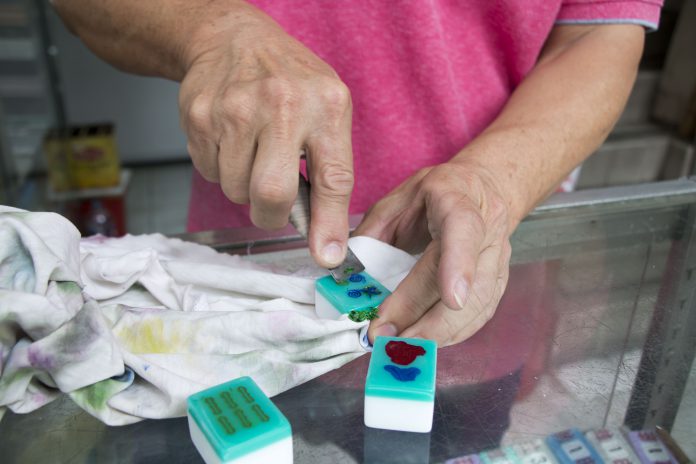Meet one of the last artisans making hand-engraved mahjong tiles
By Catherine Chiang
Under the blistering heat of the midday sun, Cheung Shun-king methodically opens up his small shop, Biu Kee Mahjong. Cheung, 63, has been in the industry for more than half a century. He demonstrates his skills by swiftly engraving patterns onto a mahjong tile, finishing one in just a few minutes.
Cheung is one of the few remaining artisans in Hong Kong who engraves mahjong tiles. Once a thriving business in the 1970s, it has been in decline since machine-made tiles came onto the market in the 1980s. Now, most mahjong sets are mass-produced in mainland factories. With so few people practising this craft, it could disappear soon.
As a third-generation engraver, Cheung witnessed the peak of the hand-carved mahjong industry. Back in the day when demand was high, the shop could sell three to five sets a day. Cheung recalled that everyone used to own a set of hand-carved mahjong, but customers today are few and far between, consisting of mostly middle-aged Hongkongers or tourists. Cheung says the older generation in Hong Kong is more appreciative of the craft because they grew up playing with this type of mahjong tile.

It takes immense effort to produce one set of mahjong, which consists of 144 tiles, so the price is high. One mahjong set costs around HK$4,000 to HK$5,000. It takes about a week to complete a set, but Cheung says most customers give him around three months to finish the work. “Rushing the process would worsen the quality of the set,” he says.
The process of carving doesn’t start with the carving itself, but with preparing the equipment. Cheung insists on sharpening his own knives. “If you buy a piece of equipment, it doesn’t suit you completely, so all of my tools I usually make myself,” he says. Most of Cheung’s tools have been in use for more than 50 years – some of them were made by his father and grandfather.
Cheung works with expert ease. He first uses a small blade to gently mark down the spots he is going to start and end with. Then, he presses down with the blade with his right hand, while his left hand turns the tile. After the carving is finished, he gets out three paint pots and brushes the paint over the tiles. Every move is planned and precise.
However, Cheung doesn’t have an apprentice to pass his skills on to, and his children are not interested. Even though he is currently in discussion with a social enterprise, Eldage, to start a class to teach his techniques, he does not have high expectations as he thinks people would just join it for fun. His industry is fading slowly, but surely, and there is not much he can do.
If you are interested in owning a set of hand-engraved mahjong, please visit G/F, 26F Jordan Road, Jordan. You can search “Biu Kee Mahjong” on Facebook for more details.
Edited by Jessica Li









































